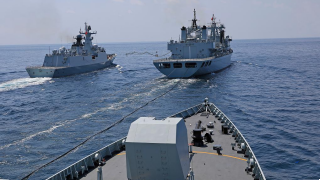“While the cat’s away, the mice will play….” may be the most apt expression of the week regarding China’s aggressive behavior overseas. With the eyes of the world targeted on the Israeli-Hamas War, Beijing’s bad conduct in the Indo-Pacific is no longer at the center of its attention. Voices of global political leaders that a week ago boisterously condemned Beijing’s incursions into neighboring states’ territories, are almost unheard above the cacophony of missiles flying above Israel. For many months intelligence analysts have considered the coming winter a highly likely period when China might act against Taiwan and other island nation-states in the Indo-Pacific.
Throughout September and into October, China has taken an increasingly assertive stance to affirm its territorial claims across what Beijing now labels the ten-dash line and the “Line of Actual Control” along the Himalayan-Indian border. China’s mountainous border with India is 2,100 miles long. With the distraction of the war in the Middle East, the likelihood of China making some type of move to asset its claims becomes greater.
Two weeks ago the Philippine Coast Guard cut apart a Chinese-installed floating barrier in the Scarborough Shoal at Huangyan Dao (黄岩岛). When questioned about the incident, PRC Foreign Ministry Spokesman Wang Wenbin (王文斌) stated that “China Coast Guard did what was necessary to block and drive away the Philippine vessel” while also repeating the false narrative that the area always belonged to China. Some analysts are suggesting that Beijing may be signaling preparations for an increased Chinese Navy presence in the area.
What is significant about this incident in contrast to earlier ones is that reports indicate there was interaction between a Chinese “Coast Guard” ship and Philippine “Navy warship.” In the past contact was between the two countries coast guards. In this latest incident China blamed the Philippines, despite the earlier finding by the Permanent Court of Arbitration under the UNCLOS. This sets up a situation in which China can play victim to a domestic audience and increase pressure on the PLA and CCP to respond to the incident. What happens next near either the Scarborough Shoal or Second Thomas Shoal may be indicative of China’s longer-term intentions. China’s cartographic expansion in the Himalayas and along the ten-dash line in the South China Sea occurred within four weeks of each other.
These incidents have increased both the security threat to and solidarity among China’s neighbors as Beijing has clearly stated it will not back down. The most recent incident prompted India and the Philippines to explore various forms of mutual defense cooperation. It is likely China will respond with additional economic coercion, influence operations and requests to Russia to increase pressure on India, according to Peter Chalk of the Jamestown Foundation.
Last June, at the fifth session of the Joint Commission on Bilateral Cooperation (JCBC) in New Delhi, Enrique Manalo, the Philippine Secretary of Foreign Affairs and India’s External Affairs Minister, Dr. Suhrahmanyam Jaishankar, issued a joint communique calling for adherence to the 2016 Arbitral Award on the South China Sea. This was India’s first explicit endorsement of the Permanent Court’s ruling in favor of Manila. Previously, India held a neutral position. “The June 2023 statement is…a highly symbolic diplomatic gesture,” says Chalk, “indicating a burgeoning bilateral relationship between New Delhi and Manila to promote an open, rules-based order in the Indo-Pacific.”
Chinese leader Xi Jinping counted on Indian prime minister Modi not to oppose its actions in the South China Sea to avoid provoking Beijing into expanding its South China Sea presence. Such expansion could not only impact India’s economic development but also the regional balance of power and political stability in the Indo-Pacific. In August, The Economic Times reported that the Philippine and Indian Coast Guards signed a memorandum of understanding to expand professional maritime linkages involved in law enforcement, search and rescue, and pollution response, as well as exploring addition areas for future joint exercises and training collaboration. As Modi takes on a more active role in the Indo-Pacific, he is also courting the United States. During his June visit to Washington, DC, to meet with President Biden, the two leaders declared themselves to be “among the closest partners in the world” and to counter Chinese aggression in the South China Sea. India’s Quad membership has also reinforced its determination to oppose China’s rising influence in the Indo-Pacific.
Although short of an official Indian-Philippine alliance, this latest incident may also open the door for the sale of Indian advanced military technologies to the Philippines, including a number of MK III multi-role light helicopters and other advanced weapon platforms. In turn, China will likely view event as an attempt by Washington to unjustifiably contain China in its own geostrategic backyard and use economic coercion against other Southeast Asian states to distance them from the Indo-Philippine partnership. The coming months will be revealing if the CCP decides its needs Russia’s assistance with New Delhi. India still relies heavily on Moscow for about 45 percent of its arms imports. The turbulence in the Middle East may provide China the cover its needs to move its Indo-Pacific agenda forward, while the world watches wars further West.
Daria Novak served in the U.S. State Dept.
Photo: Chinese 45th Fleet naval exercises (China Ministry of Defense photo)
